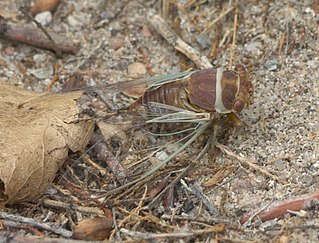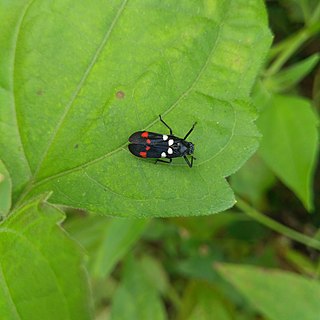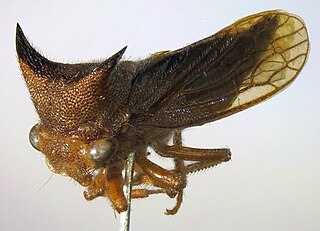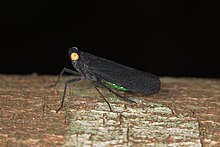
Pyrops is a genus of planthoppers that occur primarily in southeast Asia, containing about 70 species. They are fairly large insects, with much of the length due to an elongated, upcurving, snout-like projection of the head. The wings are generally brightly patterned in contrasting colors, and they are popular among collectors.

Ricaniidae is a family of planthopper insects, containing over 400 species worldwide. The highest diversity is in tropical Africa and Asia and in Australia, with a few species occurring in the Palearctic and Neotropical realms. It is one of the smaller families in the planthopper superfamily Fulgoroidea.

The subfamily Aphaeninae is a group of hemipteran insects, especially abundant and diverse in the tropics. They belong to the Fulgoridae (fulgorids), though they are not among the better-known members of that family that are called "lantern bugs" or "lanternflies". In 2009, the first molecular analysis of the Fulgoridae challenged the existing structure of eight currently recognized subfamilies and eleven tribes.

Flatidae are a family of fulgoroid planthoppers. They are cosmopolitan in distribution and are distinguished from others in the superfamily by a combination of characters. Like all other planthoppers, they suck phloem sap of plants. Some species are known to communicate with vibrations through the plant stems. Communication may be with mates, or with ants that tend the nymphs, protecting them and gathering honeydew secretions. Adults of some species have brightly coloured forewings which are tougher and known as tegmina unlike the membranous hindwings which are used for flight. Although a few can be identified by their coloration, most species requires dissection and examination under a microscope with access to literature on already described species.

Issidae is a family of planthoppers described by Spinola in 1839, belonging to the order Hemiptera, suborder Auchenorrhyncha superfamily Fulgoroidea.

Gergithus is a genus of tropical Asian planthoppers in the family Issidae, erected by Carl Stål in 1870. Like all planthoppers, adults feed on plant sap and are capable of escaping by leaping. The genus like other members in the tribe appears somewhat rounded and beetle-like, in some cases, with a mimetic resemblance to ladybird beetles. Species are mostly distributed in the Indomalayan Realm.

Calyptoproctus is a genus of planthoppers in the family Fulgoridae; records are from Central and South America.

The Fulgorinae are a sub-family of insects in the Auchenorrhyncha: which include the spectacular "lantern-bugs" and allied insects.

Diceroprocta is a genus of scrub cicadas in the family Cicadidae. There are at least 60 described species in Diceroprocta.

Iassinae is a subfamily of leafhoppers in the family Cicadellidae.

The subfamily Poiocerinae include Hemipteran insects in the family Fulgoridae, found especially in the tropics.

Ambragaeana is a genus of Asian cicadas in the tribe Gaeanini. This genus was previously placed in Gaeana and species in this tribe are often called "butterfly cicadas" because of the colours and patterns of their wings.

Callitettix is a genus of bugs in the family Cercopidae ("froghoppers") in the suborder Auchenorrhyncha and the monotypic subfamily Callitettixinae. The recorded distribution for species is in mainland Asia: from India to southern China and Indochina.

Cosmoscarta is a genus of froghoppers found in the Indo-Malayan region. Many of the species are boldly marked in black and red or yellow. A few species are of economic importance as they can cause injury to plants under cultivation.
Hypaepa is a genus of planthoppers in the family Fulgoridae, subfamily Poiocerinae. Species are distributed in Central America.
Tragopa is a genus of treehoppers. It belongs to the tribe Tragopini in the subfamily Smiliinae. It contains 41 species. It was described by Pierre André Latreille in 1829.
Adippe is a genus of treehoppers belonging to the tribe Polyglyptini, in the subfamily Smiliinae, that contains 8 species.
Euritea is a genus of treehoppers belonging to the subfamily Smiliinae. It was first described by Carl Stål in 1867, and contains three species.

Tolania is a genus of treehopper belonging to the subfamily Nicomiinae. It was first described by Carl Stål in 1858. It contains 69 species.

Scaralis is a genus of planthoppers in the family Fulgoridae occurring in Central America and South America. The genus contains 13 species, placed into two subgenera.
















